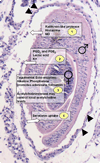Manipulation of vascular function by blood flukes?
- PMID: 21543145
- PMCID: PMC3113519
- DOI: 10.1016/j.blre.2011.04.002
Manipulation of vascular function by blood flukes?
Abstract
Schistosomes (blood flukes) are long lived, intravascular parasites that afflict ~200 million people worldwide. Here we review the potential ability of these parasites to exert control on local vascular physiology. We examine schistosome kallikrein-like proteins that drive vasodilation. We review biogenic amine metabolism in the parasites that involve the vasodilator histamine and its receptors and the vasoconstrictor serotonin and its receptor. Schistosomes can trigger the release of histamine from host cells and can import serotonin. We consider the ability of schistosomes to generate and release the eicosanoid vasodilators PGD(2) and PGE(2) and the vasoconstrictors LTB(4) and LTC(4). The literature on nitric oxide metabolism in these blood flukes is assessed. Finally the potential impact of other schistosome metabolic processes (e.g. exogenous adenosine generation and acetylcholine degradation) on vascular function is appraised. An increased understanding of these processes could lead to novel anti-parasitics as well as new therapies to treat vascular dysfunction.
Copyright © 2011 Elsevier Ltd. All rights reserved.
Conflict of interest statement
The authors declare that no conflict of interest exists.
Figures

Similar articles
-
Biogenic amines and the control of neuromuscular signaling in schistosomes.Invert Neurosci. 2012 Jun;12(1):13-28. doi: 10.1007/s10158-012-0132-y. Epub 2012 Apr 18. Invert Neurosci. 2012. PMID: 22526557 Review.
-
Exploring the role of biogenic amines in schistosome host-parasite interactions.Trends Parasitol. 2015 Sep;31(9):404-5. doi: 10.1016/j.pt.2015.07.003. Epub 2015 Aug 5. Trends Parasitol. 2015. PMID: 26254959
-
Schistosome immunomodulators.PLoS Pathog. 2021 Dec 30;17(12):e1010064. doi: 10.1371/journal.ppat.1010064. eCollection 2021 Dec. PLoS Pathog. 2021. PMID: 34969052 Free PMC article. Review.
-
The Tao survivorship of schistosomes: implications for schistosomiasis control.Int J Parasitol. 2016 Jun;46(7):453-63. doi: 10.1016/j.ijpara.2016.01.002. Epub 2016 Feb 9. Int J Parasitol. 2016. PMID: 26873753 Review.
-
Schistosoma genomics: new perspectives on schistosome biology and host-parasite interaction.Annu Rev Genomics Hum Genet. 2009;10:211-40. doi: 10.1146/annurev-genom-082908-150036. Annu Rev Genomics Hum Genet. 2009. PMID: 19630560 Review.
Cited by
-
Vitamin B6 Acquisition and Metabolism in Schistosoma mansoni.Front Immunol. 2021 Feb 4;11:622162. doi: 10.3389/fimmu.2020.622162. eCollection 2020. Front Immunol. 2021. PMID: 33613557 Free PMC article.
-
Interference with the host haemostatic system by schistosomes.PLoS Pathog. 2013;9(12):e1003781. doi: 10.1371/journal.ppat.1003781. Epub 2013 Dec 26. PLoS Pathog. 2013. PMID: 24385897 Free PMC article. Review.
-
Serine proteases activity in miracidia of Fasciola hepatica and effects of chemical and herbal inhibitors.Vet Res Forum. 2021;12(3):291-295. doi: 10.30466/vrf.2019.99959.2387. Epub 2021 Sep 15. Vet Res Forum. 2021. PMID: 34815839 Free PMC article.
-
Characterization of glutamate carboxypeptidase 2 orthologs in trematodes.Parasit Vectors. 2022 Dec 20;15(1):480. doi: 10.1186/s13071-022-05556-5. Parasit Vectors. 2022. PMID: 36539882 Free PMC article.
-
Basic Coagulation Profiles and Platelet Count Among Schistosoma mansoni-Infected Adults Attending Sanja Primary Hospital, Northwest Ethiopia.Res Rep Trop Med. 2020 Apr 22;11:27-36. doi: 10.2147/RRTM.S244912. eCollection 2020. Res Rep Trop Med. 2020. PMID: 32368171 Free PMC article.
References
-
- Koukounari A, Gabrielli AF, Toure S, Bosque-Oliva E, Zhang Y, Sellin B, et al. Schistosoma haematobium infection and morbidity before and after large-scale administration of praziquantel in Burkina Faso. J Infect Dis. 2007;196:659–669. - PubMed
-
- King CH, Dickman K, Tisch DJ. Reassessment of the cost of chronic helmintic infection: a meta-analysis of disability-related outcomes in endemic schistosomiasis. Lancet. 2005;365:1561–1569. - PubMed
-
- King CH, Dangerfield-Cha M. The unacknowledged impact of chronic schistosomiasis. Chronic Illn. 2008;4:65–79. - PubMed
-
- Skelly P. Fighting killer worms. Sci Am. 2008;298:94–99. - PubMed
-
- Wilson RA, Draskau T, Miller P, Lawson JR. Schistosoma mansoni: the activity and development of the schistosomulum during migration from the skin to the hepatic portal system. Parasitology. 1978;77:57–73. - PubMed
Publication types
MeSH terms
Substances
Grants and funding
LinkOut - more resources
Full Text Sources
Miscellaneous

